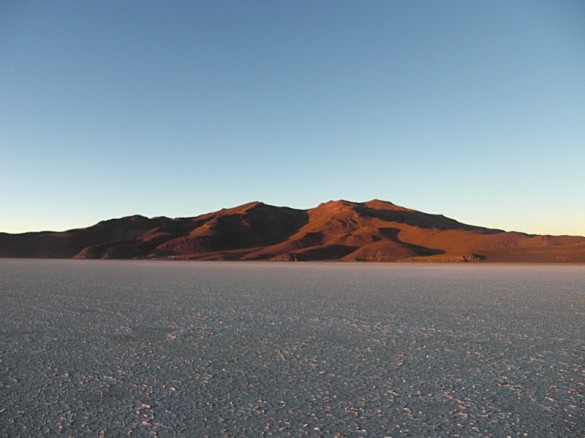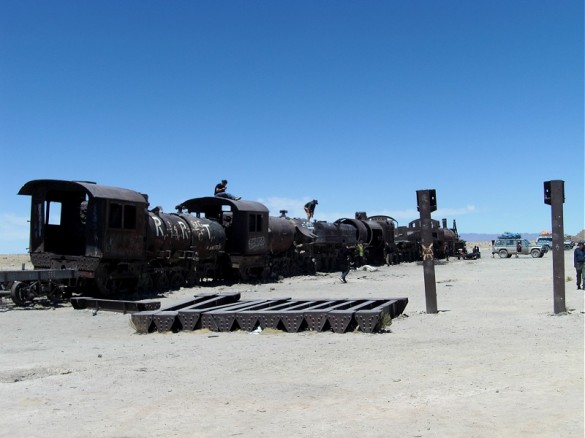Another sleepless night, but the altitude sickness is wearing off, and I feel surprisingly fresh. With military efficiency we get up, get ready, pack our stuff, and eat breakfast. We want to see the sun rise over the middle of the salt flats, no time to waste. Stuff on top of the car, ourselves inside the car, and race to get as far out as possible before the sun rises. Our German astronomer friend knows his stuff, and down to the minute he predicts how long time we have before the sun is up.
Other cars are racing alongside ours. Like little boys with toys the drivers really push their vehicles to the limit. Looking back we’re putting some serious miles behind us, the mountains become smaller and smaller. Looking at the horizon ahead, the distance to the mountains ahead seems to remain unchanged. What used to be a lake dried up to become this largest salt flats in the world – some 25 times larger than the famous Bonneville salt flats in Utah. We’re beginning to realize the greatness of this place.
When the sun is on the brim of rising above the mountains we halt. Jumping out of the car we’re now walking on salt. A 360 degrees spin, all we see is salt. Only the mountains at a far away distance break the white scenery. Our elongated shadows on the flat and white surface make a comical picture. This bizarre landscape offer some surrealistic photo ops.

“A picture is worth a thousand words” doesn’t even apply here. How do you explain an optical illusion in words?
Back in the car, we ask Marco if there are any restrictions on where they are allowed to drive. Living in the organized western society with strict traffic rules and regulations, and where parking on a lawn is considered driving off-road, the question is justified. His answer is simply “no”, and to demonstrate this he steers away from the straight course we’re currently holding. Out here there are no speed limits, no roads, no signs. A wet dream for anyone who finds even the slightest joy in driving; open and never-ending landscape, putting the pedal to the metal, no barriers. But we’re the passengers, we don’t get to drive, only dream.
Having seen salt to last for many lifetimes, our stop at the Isla Pescado is a welcome break. Rising as an island in the white desert, this rock is yet another dreamlike sight. Total silence except for our own voices. A countless amount of cacti. Very large and very old cacti. The oldest cactus some 1200 years old – a baby cactus 700 years before the first Europeans even set foot on the South American continent. Feeling inferior to a cactus sounds preposterous, but I have to bow for the largest still living one – 900 years old, standing 9 meters tall.
A salt hotel, now turned into a museum, is also on the agenda this day. Coming from the north, naturally I’m familiar with ice hotels. The concept is the same; as much as possible made out of one single material. Having viewed salt as only a something that comes out of the salt dispenser on top of your food, this mineral has now taken things to a completely different level. Walls, roof, floor, beds, chairs, tables, decorations, even a clock – all made out of salt.
We’re approaching our destination Uyuni. We pass a truck where a few men are loading salt. Marco tells us that a truckload of salt pays some $80, and takes 3 to 4 hours to fill. It’s hard and tedious manual labor. Suddenly my office job doesn’t seem so bad.

The final sight of our tour is the train cemetery just outside of Uyuni. The city used to serve as an important hub for the transport of minerals from the highlands to the Pacific Ocean ports. When the mineral industry collapsed in the 1940’s, the trains were just parked outside of Uyuni and left to their fate.
These massive machines could be a century old, standing still for 70 years. As expected, time has taken its toll, and rust is the theme for the site. Still, the dry environment has preserved these iron beasts well. Even though we’re exhausted after three days of adventure and transport, we gather some strength for to explore this peculiar graveyard. Climbing on and in real locomotives still brings out your inner child.
The tour has come to an end when Marco drops us off at the Colque Tours office in Uyuni. It’s been an adventure, with sights and stories to last for many years to come. We couldn’t have asked for a better driver than Marco, and thank him for the trip. Off to explore Uyuni before the evening. We all go our own ways from here. That is to say, various are the ways to different Internet cafes…